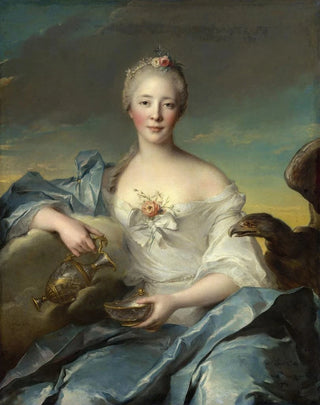Art print | Madame Le Fèvre de Caumartin as Hebe - Jean-Marc Nattier


View from behind

Frame (optional)
In the world of rococo portraiture, the artwork "Madame Le Fèvre de Caumartin as Hebe" by Jean-Marc Nattier stands out for its grace and elegance. This painting, which captures the very essence of 18th-century feminine beauty, depicts the renowned French courtesan as the goddess Hebe, the cupbearer of the gods. Through this piece, Nattier does not merely paint a figure; he immortalizes an ideal, a suspended moment in time where mythology and reality intertwine. Viewing this art print transports the viewer to a realm where lightness and delicacy reign supreme, offering a captivating introduction to Nattier's art and the aesthetic of his era.
Style and uniqueness of the work
Nattier's style is characterized by remarkable finesse and meticulous attention to detail. In "Madame Le Fèvre de Caumartin as Hebe," the pastel color palette, soft and luminous, evokes an atmosphere of serenity and well-being. The drapery of the model's gown is rendered with such mastery that it appears almost alive, while the graceful pose of Madame Le Fèvre, slightly turned, creates a subtle dynamic that draws the eye. Mythological elements, such as the cup of nectar she holds in her hand, reinforce the connection between the subject and her divine role. This piece exemplifies Nattier's ability to fuse intimate portraiture with allegorical representation, offering a unique vision of women in 18th-century society.
The artist and his influence
Jean-Marc Nattier, born in 1685, is one of the most emblematic artists of the rococo movement. Trained at the Royal Academy of Painting and Sculpture, he developed a style that combines the tradition of great masters with a new sensitivity, characteristic of his time. Nattier specialized in portraiture, particularly of female figures, and his work influenced many contemporary and future artists. His ability to capture the beauty and personality of his models, while incorporating mythological references, made him a key figure in the artistic landscape of his era.

Matte finish

View from behind

Frame (optional)
In the world of rococo portraiture, the artwork "Madame Le Fèvre de Caumartin as Hebe" by Jean-Marc Nattier stands out for its grace and elegance. This painting, which captures the very essence of 18th-century feminine beauty, depicts the renowned French courtesan as the goddess Hebe, the cupbearer of the gods. Through this piece, Nattier does not merely paint a figure; he immortalizes an ideal, a suspended moment in time where mythology and reality intertwine. Viewing this art print transports the viewer to a realm where lightness and delicacy reign supreme, offering a captivating introduction to Nattier's art and the aesthetic of his era.
Style and uniqueness of the work
Nattier's style is characterized by remarkable finesse and meticulous attention to detail. In "Madame Le Fèvre de Caumartin as Hebe," the pastel color palette, soft and luminous, evokes an atmosphere of serenity and well-being. The drapery of the model's gown is rendered with such mastery that it appears almost alive, while the graceful pose of Madame Le Fèvre, slightly turned, creates a subtle dynamic that draws the eye. Mythological elements, such as the cup of nectar she holds in her hand, reinforce the connection between the subject and her divine role. This piece exemplifies Nattier's ability to fuse intimate portraiture with allegorical representation, offering a unique vision of women in 18th-century society.
The artist and his influence
Jean-Marc Nattier, born in 1685, is one of the most emblematic artists of the rococo movement. Trained at the Royal Academy of Painting and Sculpture, he developed a style that combines the tradition of great masters with a new sensitivity, characteristic of his time. Nattier specialized in portraiture, particularly of female figures, and his work influenced many contemporary and future artists. His ability to capture the beauty and personality of his models, while incorporating mythological references, made him a key figure in the artistic landscape of his era.






